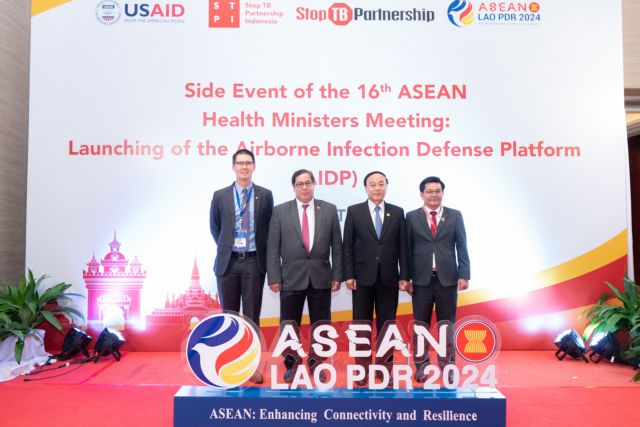 Society
Society


|
| Leaders pose for a photo during the launch of the Airborne Infection Defense Platform (AIDP) at the 16th ASEAN Health Ministers Meeting to strengthen ASEAN’s pandemic preparedness and defense against airborne infectious diseases. – Photo courtesy of Airborne Infection Defense Platform |
VIENTIANE, LAOS — The Airborne Infection Defence Platform (AIDP) was officially launched on Thursday to strengthen ASEAN countries’ tuberculosis (TB) response, and health care system and pandemic preparedness to address the growing issue of airborne respiratory infections.
The initiative was inaugurated at a side event of the 16th ASEAN Health Ministers Meeting (AHMM), where Government leaders from ASEAN member states gathered to improve understanding of TB and pandemic preparedness across ASEAN, enhance stakeholder cooperation, and strengthen nations’ capacity to address airborne respiratory infections.
AIDP is supported by the United States Agency for International Development (USAID) and implemented by the Stop TB Partnership and Stop TB Partnership Indonesia (STPI), a non-governmental organisation that works towards the elimination of TB. The platform is endorsed by the ASEAN member states.
Bounfeng Phoummalaysith, Minister of Health of the Lao PDR, said: “The Covid-19 pandemic impacted nearly every aspect of human life. We must learn from our experiences and be better prepared for any similar situations in the future. Our regional health system is evolving and we need to create a stronger and more resilient system. The TB programme has several management principles that can be easily adopted for any airborne disease, such as rapid screening tools, contact tracing, digital and community systems, and early warning systems. We need to invest in platform technologies and create infrastructure that can be deployed for future airborne pandemics.”
Aiming to enhance cooperation to combat airborne respiratory infections, the AIDP will work together with ASEAN member states and key global organisations to agree upon policies and methodologies, as well as exchange knowledge, use of infrastructure, platform technology and manpower to create surge capacity for TB cases and enhance pandemic preparedness.
After conducting a landscape assessment, the AIDP will focus on strengthening pandemic and TB responses in each ASEAN country, including at the community and primary care levels. This will be done by enhancing existing healthcare infrastructure to improve detection, treatment, and prevention.
It will also include leveraging platform technologies that have developed since the Covid-19 pandemic, including portable digital X-rays that enable testing to be done locally without the need for people to travel to hospitals or clinics, rapid molecular diagnostic platform technologies, and real-time digital surveillance tools.
These various TB preparedness measures will be beneficial in facing a future pandemic, which is highly likely to be an airborne infectious disease.
More than 2.4 million people across ASEAN are estimated to be affected by TB, based on the Global TB Report 2023. Five ASEAN countries including Indonesia, Myanmar, the Philippines, Thailand and Việt Nam are on the World Health Organisation (WHO) list of countries with high burden TB.
Furthermore, the Covid-19 pandemic had devastated national TB prevention and treatment programmes as personnel and resources were redirected from TB to Covid-19, leading to an estimated increase of almost half a million additional deaths of TB from 2020 to 2022.
According to the WHO, Việt Nam ranked 11th out of 30 countries with the highest burden of TB and drug-resistant TB in the world. Data from the Việt Nam National Tuberculosis Control Programme shows that nearly 40 per cent of people with TB in the community have not been detected, treated or reported.
At the national level, over 100,000 tuberculosis patients are detected each year, with a successful treatment rate of over 90 per cent. -- VNS




